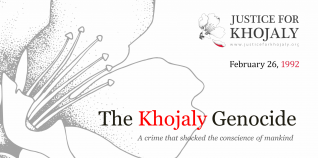Dwarfed by Azerbaijan's surroundings
 New Zealand`s Stuff.co.nz news portal has published an article about Azerbaijan.
New Zealand`s Stuff.co.nz news portal has published an article about Azerbaijan.
Titled “Dwarfed by Azerbaijan's surroundings” the article says: “Azerbaijan's capital on the shores of the Caspian Sea, has up until recently been known primarily as a city growing rich on oil and natural gas.
That's if people can find it on the map at all. This small country, which was until the 1990s part of the Soviet Union, is rather off the beaten track, sharing borders with Russia, Georgia, Armenia, Turkey and Iran.
Azerbaijan is in the world's top 20 oil-producing nations as well as owning one of the world's biggest natural gas fields. The country has literally oozed oil - traveller Marco Polo observed in the 13th century that the oil was not good to eat but burned well and was also very useful for camels suffering from itchy skin conditions. Natural gas spontaneously combusted, providing ready fuel for the temples of the fire-venerating Zoroastrians whose religion once dominated the region.
Today, the flow of oil is carefully controlled and it is high performance sports cars and Hummers rather than camels that help to consume local supplies.
Baku comes as something of a shock to travellers imagining an exotic East meets West crossroads; a place of caravanserai and mosques blended with European and Russian-inspired architecture. And yes, there are elements of this blurred boundary between cultures and religions, but Baku is an increasingly sophisticated city that appears nowadays to be looking more to the West than to the East.
Oil has been traded in Azerbaijan since at least the 3rd and 4th centuries but it wasn't until the late 19th century that the country began to experience its first boom, which brought with it grand buildings, mansions and parks. By 1901 the country was producing half the world's oil supplies. The world's first oil field was developed here and the world's first tanker was constructed here to ferry oil supplies into the heart of the Russian empire. This was the work of the Nobel brothers no less (Ludvig, Robert and Alfred, the latter the founder of the Nobel prizes).
During World War II, the Azeri oil fields kept almost the entire Soviet war effort fuelled and were thus a prime target for invasion by Hitler's forces. So sure was the German military hierarchy that they would achieve this, the story goes, that they presented Hitler with a cake representing the region and gave him the piece featuring Baku. However, Hitler didn't get the chance to have his cake and eat it as the German forces were eventually driven from the region.
Today the ever-growing flow of oil money has helped fuel extensive renovations and restorations of its historic city centre and of its 19th century European and Russian-influenced buildings that were constructed during the early days of oil exploration.
Oil money is also funding a whole new wave of construction; hundreds of new apartment blocks are springing up beside the Caspian, there are shopping malls and boutiques sporting all the big brand names but there are also some jaw-dropping examples of cutting-edge innovative architecture among this.
The Flame Towers, a trio of 190m tall skyscrapers that were completed in 2012 at an estimated cost of about US$350m, are Azerbaijan's most visible symbol of its newfound prosperity. The buildings with their graceful curves are stunning by day but are simply spectacular in the evenings when for about two hours their glass flanks are transformed into giant illuminated screens.
The building was designed by British-Iraqi architect Zaha Hadid. Hadid was awarded the Nobel prize equivalent of architecture in 2004 and in 2010 Time magazine named her as one of the world's most 100 influential people. The centre is named after Heydar Aliyev.”




















